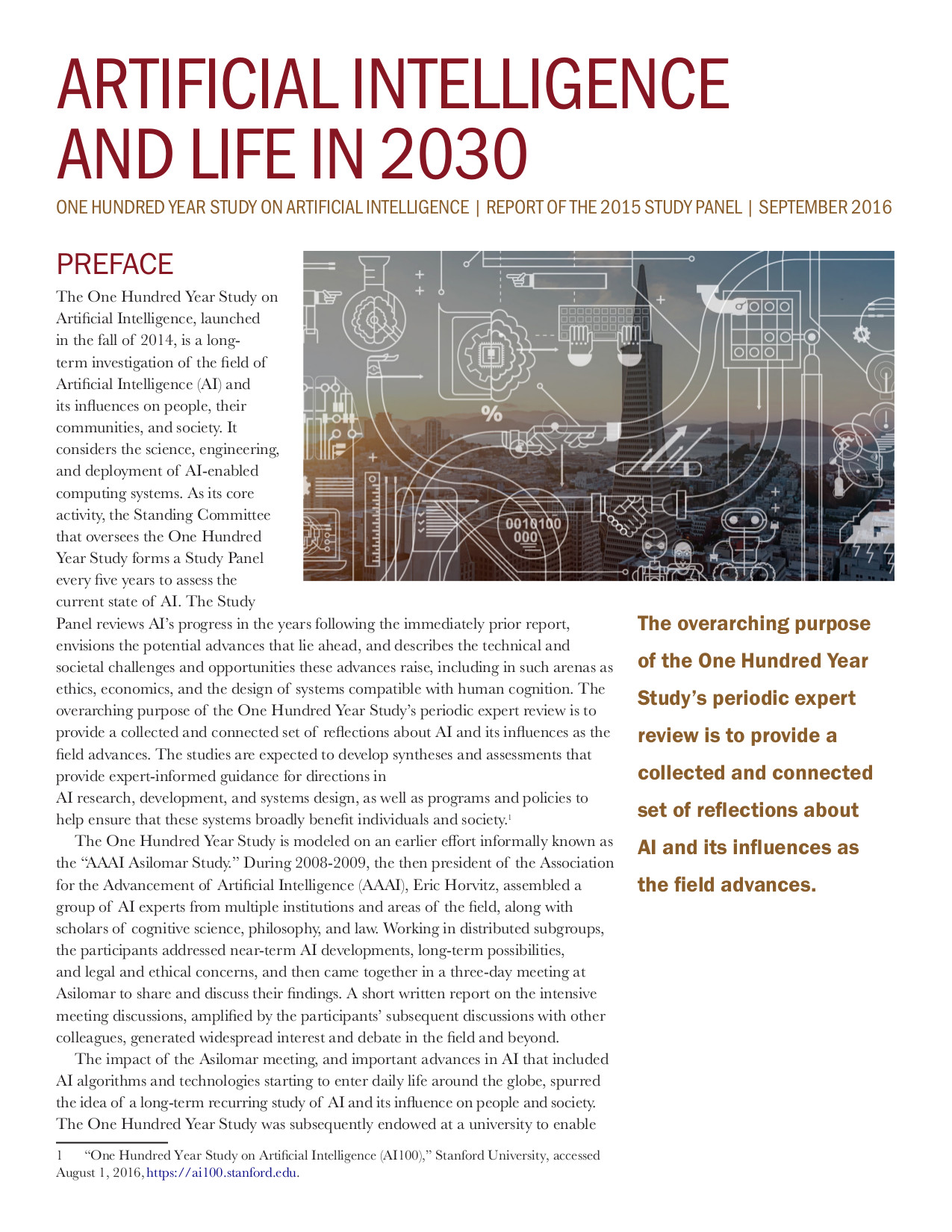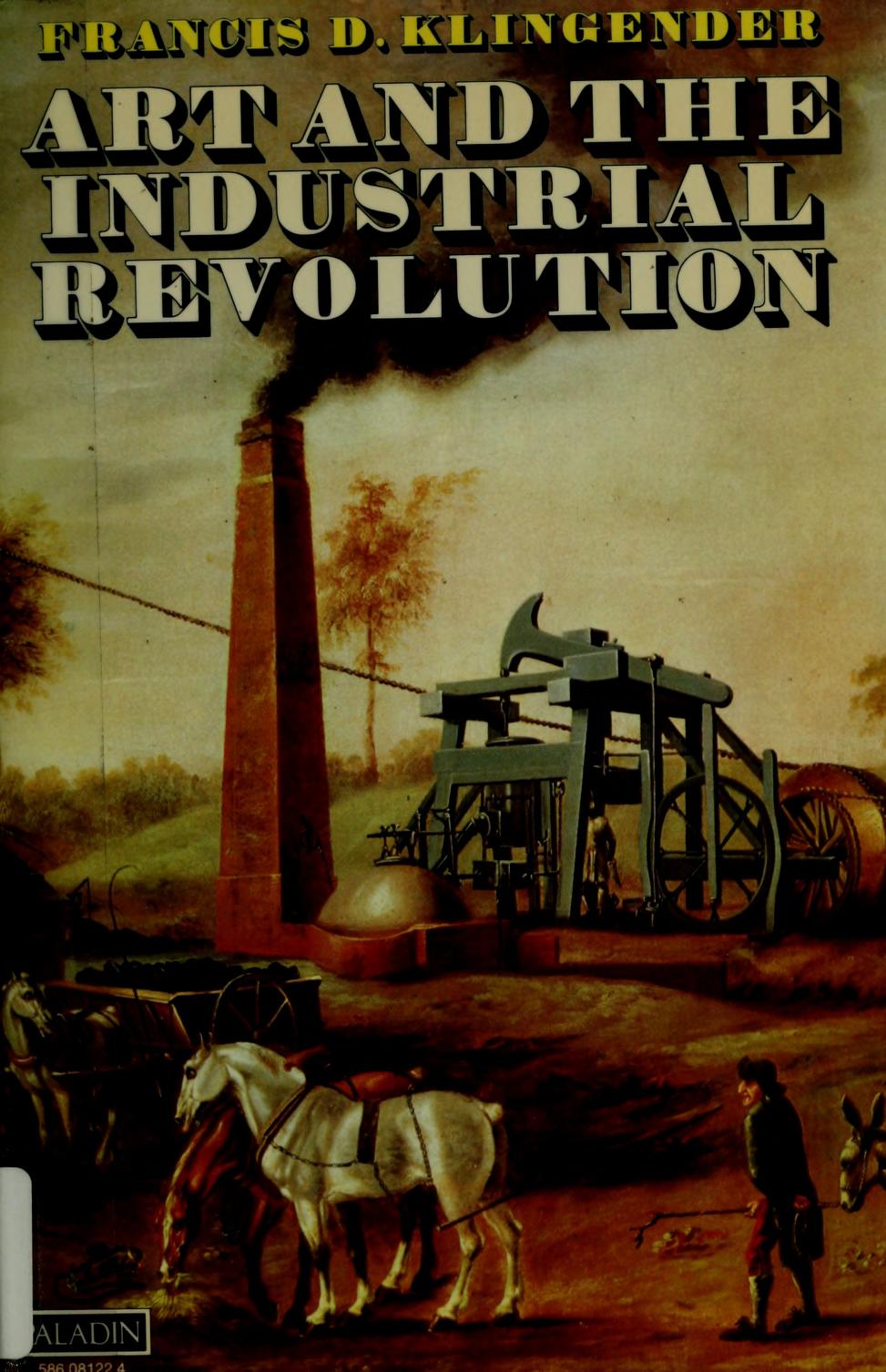Artificial Intelligence and Life in 2030: One Hundred Year Study on Artificial Intelligence (2016)
Filed under report | Tags: · artificial intelligence, computing, industry, machine learning, society, technology

“The Stanford One Hundred Year Study on Artificial Intelligence, a project that launched in December 2014, is designed to be a century-long periodic assessment of the field of Artificial Intelligence (AI) and its influences on people, their communities, and society. Colloquially referred to as “AI100″, the project issued its first report in September 2016. A Standing Committee works with the Stanford Faculty Director of AI100 in overseeing the project and designing its activities. A little more than two years after the first report appeared, we reflect on the decisions made in shaping it, the process that produced it, its major conclusions, and reactions subsequent to its release.
The inaugural AI100 report, which is titled “Artificial Intelligence and Life in 2030,” examines eight domains of human activity in which AI technologies are already starting to affect urban life. In scope, it encompasses domains with emerging products enabled by AI methods and ones raising concerns about technological impact generated by potential AI – enabled systems. The Study Panel members who authored the report and the AI100 Standing Committee, which is the body that directs the AI100 project, intend for it to act as a catalyst, spurring conversations on how we as a society might shape and share the potentially powerful technologies that AI could enable. In addition to influencing researchers and guiding decisions in industry and governments, the report aims to provide the general public with a scientifically and technologically accurate portrayal of the current state of AI and its potential. It aspires to replace conceptions rooted in science fiction books and movies with a realistic foundation for these deliberations.”
Publisher Stanford University, September 2016
Creative Commons BY-ND 4.0 International License
52 pages
Commentary: Barbara J. Grosz & Peter Stone (Communications of the ACM, 2018).
Comment (0)Francis D. Klingender: Art and the Industrial Revolution (1947–) [EN, IT, ES]
Filed under book | Tags: · 1800s, aesthetics, art history, history of literature, history of technology, industrial revolution, industry, labour, marxism, poetry, technology

A classic of Marxist art history.
“Drawing on his unique command of the contemporary visual and literary record, Francis Klingender analyzes and documents the inter-reaction between the sociological, scientific and cultural changes that moulded the 19th century. His subjects range from the development of the railways to the poetry of Erasmus Darwin, from the construction of bridges and aqueducts to the aesthetic concepts of the Sublime and the Pictoresque, from the Luddite riots and the English ‘navvy’ to those artists most profoundly affected by the climate of the Industrial Revolution, among them John Martin, Joseph Wright of Derby, J.C. Bourne, and J.M.W. Turner.” (from back cover)
Publisher N. Carrington, London, 1947
Edited and revised by Arthur Elton
Revised and expanded edition by Adams & Dart, 1968
Publisher Paladin, St Albans, 1972
ISBN 0586081224, 9780586081228
xv+272 pages
Review: Fred H. Andrews (J Royal Society of Arts, 1949).
Art and the Industrial Revolution (English, 1947/1968, 60 MB, no OCR)
Arte e rivoluzione industriale (Italian, trans. Elena Einaudi, 1972)
Arte y revolución industrial (Spanish, trans. Pilar Salso, 1983)
Henri Lefebvre: Right to the City (1968–) [FR, ES, EN, BR-PT]
Filed under book | Tags: · city, form, industry, marxism, philosophy, theory, urbanism, utopia

Lefebvre’s highly polemical book on the city was completed in 1967 to commemorate the centenary of the publication of Marx’s Das Kapital, and came out before the events of 1968.
David Harvey wrote about its central thesis: “The right to the city is far more than the individual liberty to access urban resources: it is a right to change ourselves by changing the city. It is, moreover, a common rather than an individual right since this transformation inevitably depends upon the exercise of a collective power to reshape the processes of urbanization. The freedom to make and remake our cities and ourselves is … one of the most precious yet most neglected of our human rights.” (Source)
First published in book form as Le droit à la ville, Anthropos, Paris, 1968.
English edition
Translated and Introduced by Eleonore Kofman and Elizabeth Lebas
Chapter in Writings on Cities
Publisher Blackwell, 1996
ISBN 0631191879
pages 61-181
Wikipedia (EN)
Commentary: Notbored.org (2006).
Le droit à la ville (French, one chapter only, 1967)
El derecho a la ciudad (Spanish, trans. J. Gonzalez-Pueyo, 4th ed., 1969/1978, 38 MB)
Right to the City, in Writings on Cities (English, trans. Eleonore Kofman and Elizabeth Lebas, 1996, ARG)
O direito à cidade (Brazilian Portuguese, trans. Rubens Eduardo Frias, 5th ed., 2001/2008, 5 MB)
For more from Lefebvre see Monoskop wiki.
Comment (0)
